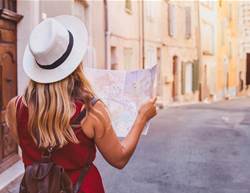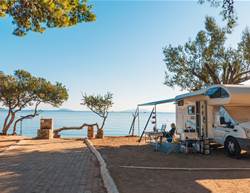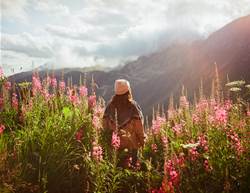Aren’t we all ready for a real getaway? It’s been at least two years since Aussies have encountered the joy of the new, the uplift that comes from being in a place that doesn’t just look different, but also sounds, smells and feels different. So, where to first? Perhaps to a place where you can cycle past paddy fields and stone temples, where frangipani and wild ginger thrive, and where the tangy scent of smoke rises from street vendors cooking over hot grills. A place of mild mornings and balmy evenings, where you can see the sun rise over still waters and watch it set while sipping lemongrass tea on an al fresco terrace.
That place is Cambodia, one of Asia’s most welcoming countries. With its ancient culture, tranquil countryside and lively cities – not to mention its friendly locals – Cambodia is the sort of soul restoring destination you’ve been hankering for. And thanks to an effective vaccination program, which saw more than 85 per cent of the population fully vaccinated by the end of 2021, it’s also an inviting destination for those with itchy feet. The nation’s best-known attraction is, of course, the extraordinary collection of Khmer temples, including the magnificent Angkor Wat. Scattered outside the city of Siem Reap – capital of the Khmer Empire between the ninth and 15th centuries, and the largest pre industrial city in the world – are more than 1000 elaborately carved Hindu and Buddhist temples.
Try not to rush the experience, though; you’ll want to spend several days getting to know some of these mighty relics. A cycle tour with a private guide is one of the best ways to get around; the flat terrain makes it easy even for non-cyclists. Make sure you bring some comfy walking shoes, as you’ll be clocking up plenty of steps on your Fitbit as you explore. The most notable temples include not just Angkor Wat, but also Ta Prohm, where the hanging vines and encroaching tree roots provided a perfect backdrop for Angelina Jolie’s star turn in the 2001 film Lara Croft: Tomb Raider, and Bayon, where dozens of stone towers are carved with the four faces of Bodhisattva Avalokiteshvara, each face four metres high.
While you’re in Siem Reap, delight in the unexpected by including a few of the lesser-known temples on your itinerary. Visit Banteay Kdei, with its maze of chambers, the eroded pyramid of Baphuon, with its magnificent views, or Beng Mealea. Half overgrown by the encroaching jungle, it’s just as dramatic as Ta Prohm, but here, the only other people you’re likely to encounter are local kids pretending to be adventurers. As you tour the temples, keep an eye out and you might spot gibbons swinging through the trees or even otters frolicking in the moats. Siem Reap was once dismissed as just a ‘temple town’. These days, however, the riverside city is a destination in its own right. Lively neighbourhoods, such as the Old French Quarter and Wat Bo, offer plenty to keep you busy, with bustling markets, boutiques and galleries, and a plethora of yoga and meditation studios and massage centres. Many yoga studios offer casual classes, so you can easily slip one into your schedule when it suits.

Into the wild...
One of Cambodia’s most intriguing conservation projects, available to travellers with a healthy budget, is the spectacular tented camp Shinta Mani Wild. Set by the Cardamom Mountains, a day’s drive south of Siem Reap, Shinta Mani Wild was created by acclaimed hotel designer Bill Bensley to provide a protected zone for local wildlife endangered by poachers. Guests are encouraged to zip line their way into camp (or your car can deliver you to the door), where 15 luxurious tents are arrayed along the river, spaced 100 metres apart from each other to give a sense of splendid isolation. To call these ‘tents’ seems somewhat understated. Each one measures 100 square metres and features a hand-carved bed and a sprawling private deck overlooking the river kitted out with a sofa, tables and chairs, a complimentary bar (there’s nothing ‘mini’ about it) and a roll-lipped bathtub. Stays at Shinta Mani Wild come with a healthy price tag (approx. $2600 per couple per night), but they include all meals, beverages and excursions as well as unlimited spa treatments, which can take place at the tree-fringed spa, in your tent or, in the case of the foot massage, while soaking in a waterfall pool. Other activities on offer include Japanese fly fishing lessons, the opportunity to join the anti-poaching rangers on their patrols, kayaking and mountain biking, cooking classes, cruises down the river on a pontoon boat, and guided jungle walks that let you spot everything from wild orchids to magnificent tropical butterflies. For more details, visit wild.bensleycollection.com

There are also lots of restaurants serving fresh, flavour-packed Cambodian cuisine piled high with aromatic herbs – everything from mango salad and Khmer noodles, loaded with crispy cucumbers, water lily stems and banana blossom, to fish curry fragrant with ginger, lemongrass and turmeric. Among Siem Reap’s most surprising attractions is Theam’s Gallery. Set amid lush gardens, this collection of airy pavilions, colonnaded corridors and tranquil ponds is jam-packed with art of all kinds. Art doesn’t just decorate the interiors here. You’ll find it displayed beside trees and out in the open. Richly coloured lacquer paintings hang on walls; jewel-coloured scarves are piled high on shelves; tiny Buddhas sit in niches; larger Buddhas look on serenely, keeping watch. As well as a gallery space, Theam’s Gallery doubles as an atelier, a place where apprentices learn Cambodian arts such as sculpting, painting and lacquering. Lim Muy Theam, the master artist who first created the gallery at his house before expanding into neighbouring properties, understands firsthand the healing power of art. Art helped him process his traumatic childhood as a child labourer under the genocidal Khmer Rouge regime that devastated the country in the 1970s.

This is one of the most uplifting facets of a visit to Cambodia: the resilience and generosity of the locals. Here, community comes first. That is why so many of Siem Reap’s creative businesses are social enterprises that give back to disadvantaged locals. Head to Artisans Angkor, for instance, for silk products handcrafted by rural youth trained in traditional techniques, or to Friends ’N’ Stuff for wallets manufactured from up-cycled rice bags or jewellery made from discarded metal, with profits going to those in need. Even a night out can be a way of giving back: Profits from Phare Circus – a memorable blend of acrobatics, live music, dance and drama – are used to help disadvantaged children get performing arts training.
Allow some time to explore out of town, too. Take a trip to Tonlé Sap, Asia’s largest freshwater lake, to visit stilted floating villages and biospheres with amazing birdlife. Choose a full-day tour to get away from over-touristed destinations and experience the more tranquil side of the lake.
You might canoe through the mangroves to the floating village of Kampong Phluk, or visit the stunning bird sanctuary Prek Toal. Come between December and February, when water levels are lower, and you’ll be amazed by the birdlife. Take in the towering milky stork and the lesser and greater adjutant storks, with their huge nests and their even mightier wingspans.
When it comes to accommodation, Siem Reap has options for every budget. If you lean towards stylish stays, consider one of the eye-catching properties designed by celebrated hotel designer Bill Bensley. The four-star Shinta Mani Shack (shack.shintamani.com) has inviting rooms overlooking a lush central courtyard, complete with pool and three restaurants, including a steak house and one dedicated to Khmer street food. Right across the road is its more indulgent sister property, Shinta Mani Angkor (angkor.shintamani.com). The chic interiors feature black, white, brown and bold orange, with plenty of lush greenery. Both hotels support the Shinta Mani Foundation, another local organisation that finances a school and provides training to unemployed youth, so you’ll leave happily knowing that you’ve done your bit for the community.
Moments of joy...
These uplifting experiences will linger in your memory long after you've returned home:
1.Catch a sunrise over the water
Keen for a tranquil start to the day? Instead of following the crowds to Angkor Wat in the morning, savour the calm scenes at the ancient bathing terrace at Srah Sarang lake.
2. Strike a pose
Siem Reap’s vast array of yoga studios offer classes in everything from yin yoga to Sivananda. Studios such as Yoga Space (yogaspace.asia) run on a social enterprise model.
3. Support the local community
Siem Reap’s boutiques and giftware shops don’t just offer great souvenirs – many of them also sell wares created by disadvantaged groups, passing on profits to the makers.
4. Cool off in a relaxing waterfall-fed pool
Kulen Mountain rises dramatically out of the flat plains around Siem Reap; at its top, two cascades feed a popular waterhole. The sacred mountain is also home to a number of temples,
including a reclining Buddha.
5. Help protect the endangered wildlife
From huge adjutant storks to elusive civet cats, Cambodia is home to a number of endangered species. Help protect them by visiting one of the country’s biospheres or wildlife reserves.


.jpg&h=90&w=90&c=1&s=1)







